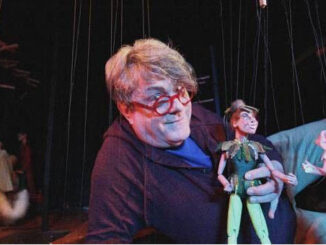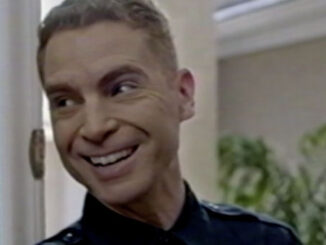The Bee Gees – brothers Barry, Robin and Maurice Gibb – were one of the most resilient music groups of the 1960s and `70s, unintentionally evolving from a British Invasion pop act into one of the reigning disco acts of the 1970s and managing to even live beyond the brief lifespan of that dance music craze.
The new documentary The Bee Gees – How Can You Mend A Broken Heart is a not-so-many-warts-included encapsulation of the group’s history, by producer-turned-director and admitted Bee Gees fan, Frank Marshall. Marshall makes copious use of archival footage and interviews to tell the story of the band’s decades-spanning career. Although interview segments consist almost exclusively of the three brothers Gibb, we do get to hear from a few of their backing band members from over the years as well as the Jonas Brothers’ Nick Jonas and Oasis’s Noel Gallagher, both of whom have their own perspectives on making music with family members.
For those unfamiliar with the band’s backstory, the documentary starts off with them as teenagers, their family British transplants to Australia. Inspired by the Beatles, they formed their own acoustic trio and soon their father was hustling gigs them. A trip to England and a demo sent to the Beatles manager Brian Epstein managed to get them a recording contract. But the group’s didn’t luck stop there. A power blackout the first evening of their recording session found the brothers sitting in a darkened hallway spontaneously writing what would become their first hit “New York Mining Disaster 1941.” But a perhaps too quick rise to the top combined with their youth and inexperience with the world led to the brothers parting ways for a bit in 1969. But the group managed to stage a return just a few years later with the song that would become their biggest hit to date “How Can You Mend A Broken Heart?”
The documentary gets the most interesting when it comes up to the late 1970s disco era and the Bee Gees’ genre defining contributions to the it via their tracks on the Saturday night Fever soundtrack album. Marshall takes a few moments to set the stage by detailing the rise of disco music from underground gay dance clubs to mainstream pop music acceptance. When approached to provide a couple of songs for an upcoming John Travolta film about the dance craze, the band was at first trepidatious as they didn’t consider themselves a dance music group. But a whirlwind writing session yielded eight songs, all of them hits when released as singles off of Saturday Night Fever’s phenomenally successful soundtrack album.
Naturally with that kind of success and visibility the group was, for better or worse, positioned as the kings of disco.
The worse arrived in the form of Chicago disc jockey Steve Dahl who spearheaded the infamous Disco Demolition Night at Cominsky Park on July 12, 1979 in which a large crate of disco albums were blown up in the middle of center field in-between the two games of a double-header between the White Sox and the visiting Detroit Tigers. The stunt damaged the field and the ensuing riot from people who charged the field, but it also set in motion a backlash against the dance music genre that would ultimately topple the brothers off the charts.
However, as How Do You Mend A Broken Heart points out, not all of the records that were brought to Cominsky Field that day were disco records, some were just R&B and funk albums by non-disco black artists like Stevie Wonder. Given the roots of disco music in the black and gay communities, and Dahl striding across Cominski Field in a faux-military uniform, the whole spectacle felt more like some kind of hateful book-burning and an eerie precursor to the reactionary conservatism of Reagan’s America in the 1980s.
But the Bee Gees fall from Top 40 grace as the disco craze flamed out did not necessarily spell the end for the group itself. Instead, they found that their songwriting prowess was in demand and soon they were crafting hits for such artists as Barbara Streisand, Dion Warwick and Kenny Rogers and Dolly Parton. The brothers even were able to get back on the road, selling out shows until untimely deaths claimed Robin and Maurice.
How Do You Mend A Broken Heart benefits greatly from lots of contemporary footage of the band on tour, in the studio and in their private lives. Most revealing is a glimpse into the writing session for “How Deep is Your Love,” which shows them working to craft the hit song.
But for all of the depth that it supplies for parts of their career, How Do You Mend A Broken Heart does zip right past some of the more rockier aspects of the Bee Gees’s public life. Mentioning the drug issues that contributed to their first breakup in the late 1960s was perhaps unavoidable but it still feels like it is being downplayed. Entirely absent is any acknowledgement of their participation in the notorious 1978 box office bomb Sgt. Pepper’s Lonely Hearts Club Band, a film that most likely accelerated their fall from Top 40 grace that would be greatly accelerated by the backlash against disco the following year.
The frame of the film is lone surviving Gibb brother, Barry, looking back at the life and career he and his siblings shared. “These are my memories,” he states at the start of the film. “I think they’re memories would be different.” But while that would suggest some sort of emotional and personal reflection, How Do You Mend A Broken Heart is mostly fairly clinical. And the film as Barry’s viewpoint is somewhat muted as Marshall has included a number of archival interviews of the other brothers and Barry at various points in their career. These help to convey the brothers’s individual states of mind at the time, but they also serve as a sad reminder that they did not live long enough to gain the perspective on their career that brother Barry offers in the modern day set one.





